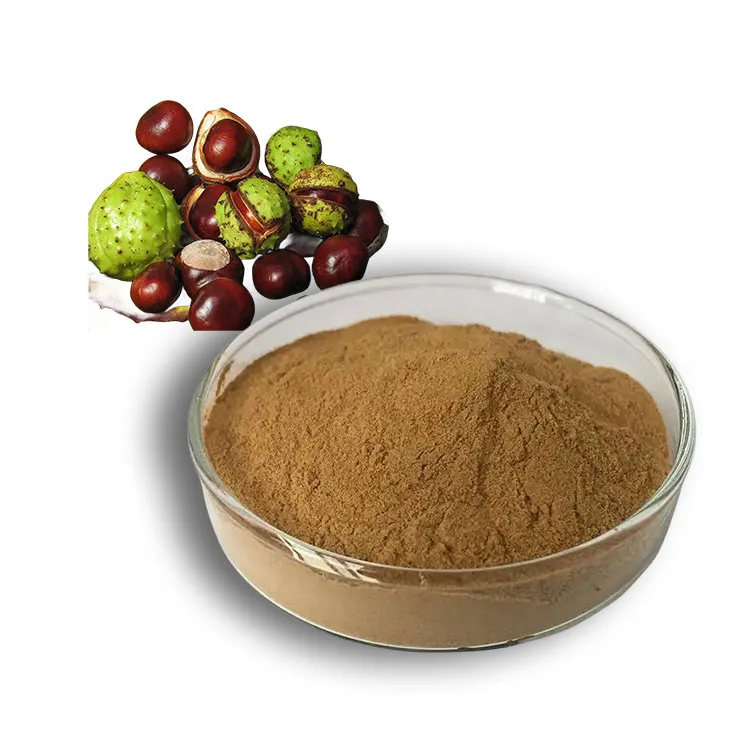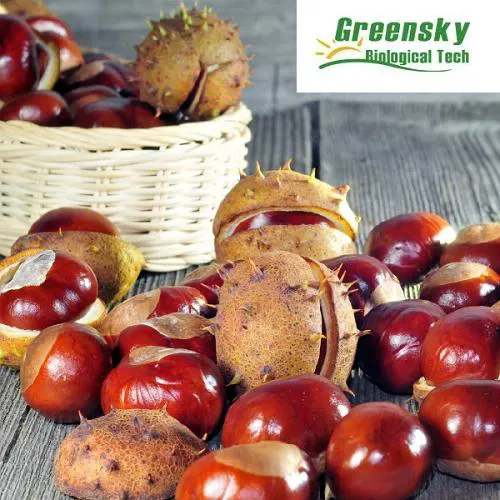- 0086-571-85302990
- sales@greenskybio.com
Manufacturers of Chinese Horse Chestnut Extract in China.
2024-11-28

1. Introduction to Chinese Horse Chestnut Extract Manufacturers in China
Chinese manufacturers of Aesculus chinensis extracts are emerging as significant players in the international arena. The extraction of Aesculus chinensis is a complex yet fascinating process. Manufacturers in China have made remarkable progress in this area. They have a deep understanding of the plant's characteristics, which allows them to select the most suitable extraction methods.

2. Extraction Methods
2.1 Solvent Extraction
One of the common methods used by Chinese manufacturers is solvent extraction. This method involves using a suitable solvent to dissolve the desired components from the Aesculus chinensis plant. The choice of solvent is crucial as it determines the efficiency of extraction and the purity of the final extract. Different solvents may be selected based on the solubility of the target compounds. For example, some solvents may be better at extracting flavonoids, while others may be more suitable for terpenoids.
2.2 Supercritical Fluid Extraction
Another advanced method is supercritical fluid extraction. In this process, a supercritical fluid, often carbon dioxide, is used as the extracting agent. Supercritical fluids have properties between those of a gas and a liquid, which makes them excellent for extracting delicate and heat - sensitive components. This method is gaining popularity among Chinese manufacturers as it can produce high - quality extracts with minimal solvent residues. It is also more environmentally friendly compared to some traditional solvent extraction methods.

3. Quality Assurance
In terms of quality, Chinese manufacturers adhere to strict international standards.
3.1 Investment in Testing Equipment
They invest in advanced testing equipment to analyze the chemical composition and properties of the extracts. High - performance liquid chromatography (HPLC) and gas chromatography - mass spectrometry (GC - MS) are some of the commonly used techniques. These instruments can accurately detect and quantify the various components in the Aesculus chinensis extract. For example, HPLC can be used to determine the concentration of flavonoids, which are important bioactive compounds in the extract.
3.2 Ensuring Safety and Effectiveness
This ensures that the products are safe and effective for various applications. In the pharmaceutical field, Aesculus chinensis extracts may be used for treating certain circulatory disorders. The strict quality control measures ensure that the extracts contain the right amount of active ingredients and are free from harmful contaminants. In cosmetics, it can be an ingredient for anti - aging and skin - firming products. Manufacturers need to ensure that the extract does not cause any adverse reactions on the skin, such as irritation or allergic reactions.

4. Advantage of China's Biodiversity
These manufacturers also benefit from China's rich biodiversity.
4.1 Stable Raw Material Supply
The wide availability of Aesculus chinensis in China provides a stable raw material supply. China has diverse geographical regions with different climates, which are suitable for the growth of Aesculus chinensis. This means that manufacturers can source high - quality raw materials locally, reducing the cost and ensuring a consistent supply. For example, in certain mountainous areas, the plant grows abundantly, and local communities may be involved in the collection and initial processing of the plant material.
5. International Cooperation
Additionally, they are actively involved in cooperation with international research institutions.
5.1 Technology Exchange
This promotes the exchange of technology and knowledge. Chinese manufacturers can learn from the advanced research methods and techniques used in other countries. For example, they may learn about new extraction technologies or quality control measures. In return, they can also share their own experiences and knowledge, especially regarding the traditional use of Aesculus chinensis in Chinese medicine.
5.2 Enhancing Competitiveness
This further enhances their competitiveness in the global market of Aesculus chinensis extracts. By collaborating with international partners, Chinese manufacturers can gain access to new markets and customers. They can also improve their product development capabilities by incorporating international research findings into their production processes. For instance, they may develop new products based on the combined knowledge of Chinese and international research on the bioactive properties of Aesculus chinensis.
6. Research and Development Efforts
Chinese manufacturers are not only focused on production but also on continuous research and development.
6.1 Exploring New Bioactive Compounds
They are constantly exploring the Aesculus chinensis plant for new bioactive compounds. Through advanced research techniques such as metabolomics, they can identify previously unknown compounds that may have potential health benefits. For example, recent research has suggested the presence of certain compounds in Aesculus chinensis that may have anti - inflammatory properties, which could be further developed for pharmaceutical or nutraceutical applications.
6.2 Product Diversification
Based on their research findings, manufacturers are diversifying their product range. In addition to the traditional extracts used in pharmaceuticals and cosmetics, they are developing new products such as dietary supplements. These dietary supplements can be formulated to target specific health conditions, such as improving blood circulation or reducing oxidative stress. The development of such products requires a deep understanding of the chemical composition of the Aesculus chinensis extract and its interaction with the human body.
7. Regulatory Compliance
In the production of Aesculus chinensis extracts, regulatory compliance is of utmost importance.
7.1 Domestic Regulations
In China, manufacturers need to comply with national regulations regarding the collection, processing, and marketing of herbal extracts. These regulations ensure the sustainable use of Aesculus chinensis resources and the safety of the products. For example, there are regulations on the proper harvesting of the plant to avoid over - exploitation and on the quality standards for the extracts produced.
7.2 International Regulations
Moreover, they also need to meet international regulations when exporting their products. Different countries may have different requirements for the safety and quality of herbal extracts. For instance, in the European Union, there are strict regulations on the registration and labeling of herbal products. Chinese manufacturers need to ensure that their Aesculus chinensis extracts meet these international standards to be able to enter and compete in the global market.
8. Market Expansion Strategies
Chinese manufacturers of Aesculus chinensis extracts are implementing various market expansion strategies.
8.1 Brand Building
They are focusing on building strong brands for their products. A well - known brand can help gain consumer trust and loyalty. Manufacturers are investing in marketing and advertising to promote their Aesculus chinensis extract - based products. They are highlighting the unique features and benefits of their products, such as their high quality and natural origin. For example, some manufacturers are using social media platforms to reach a wider audience and create brand awareness.
8.2 Market Segmentation
Another strategy is market segmentation. They are identifying different market segments based on factors such as consumer needs, geographical location, and application areas. For example, they may target the high - end cosmetics market in developed countries with their premium - quality Aesculus chinensis extract - based anti - aging products. At the same time, they may also focus on the domestic pharmaceutical market for products used in treating circulatory disorders.
9. Challenges and Solutions
Despite their progress, Chinese manufacturers of Aesculus chinensis extracts also face some challenges.
9.1 Competition from Other Countries
There is competition from other countries that also produce herbal extracts. Some countries may have lower production costs or different marketing strategies. To overcome this, Chinese manufacturers are focusing on differentiating their products through quality, innovation, and brand building. They are highlighting the unique qualities of Aesculus chinensis from China, such as its rich bioactive compound profile due to China's specific ecological conditions.
9.2 Environmental Concerns
The extraction process may have environmental impacts, such as solvent waste disposal. To address this, manufacturers are increasingly adopting more environmentally friendly extraction methods like supercritical fluid extraction. They are also implementing waste management strategies to reduce their environmental footprint. For example, they are recycling solvents or treating waste water properly to meet environmental regulations.
10. Conclusion
In conclusion, Chinese manufacturers of Aesculus chinensis extracts have made great strides in recent years. They have advanced extraction methods, strict quality control, benefit from China's biodiversity, engage in international cooperation, and are implementing effective market expansion strategies. Despite facing challenges, they are well - positioned to continue growing in the global market of Aesculus chinensis extracts. Their continuous research and development efforts, along with regulatory compliance, will further enhance their competitiveness and contribute to the wider use of Aesculus chinensis extracts in various fields such as pharmaceuticals, cosmetics, and dietary supplements.
FAQ:
What are the common extraction methods used by Chinese manufacturers for Aesculus chinensis extracts?
Chinese manufacturers may use solvent extraction or supercritical fluid extraction, depending on the desired components of the extract.
How do Chinese manufacturers ensure the quality of Aesculus chinensis extracts?
They adhere to strict international standards and invest in advanced testing equipment to analyze the chemical composition and properties of the extracts, ensuring the products are safe and effective for various applications.
What are the applications of Aesculus chinensis extracts in the pharmaceutical field?
In the pharmaceutical field, Aesculus chinensis extracts may be used for treating certain circulatory disorders.
What role does China's biodiversity play for Chinese manufacturers of Aesculus chinensis extracts?
China's rich biodiversity provides a stable raw material supply as Aesculus chinensis is widely available in China for these manufacturers.
How do Chinese manufacturers enhance their competitiveness in the global market of Aesculus chinensis extracts?
They are actively involved in cooperation with international research institutions, which promotes the exchange of technology and knowledge, further enhancing their competitiveness.
Related literature
- Title: Study on the Extraction and Application of Aesculus chinensis Extracts"
- Title: "Quality Control of Aesculus chinensis Extracts in Chinese Manufacturers"
- Title: "The Role of Chinese Manufacturers in the Global Aesculus chinensis Extract Market"
- ▶ Hesperidin
- ▶ Citrus Bioflavonoids
- ▶ Plant Extract
- ▶ lycopene
- ▶ Diosmin
- ▶ Grape seed extract
- ▶ Sea buckthorn Juice Powder
- ▶ Fruit Juice Powder
- ▶ Hops Extract
- ▶ Artichoke Extract
- ▶ Mushroom extract
- ▶ Astaxanthin
- ▶ Green Tea Extract
- ▶ Curcumin
- ▶ Horse Chestnut Extract
- ▶ Other Product
- ▶ Boswellia Serrata Extract
- ▶ Resveratrol
- ▶ Marigold Extract
- ▶ Grape Leaf Extract
- ▶ New Product
- ▶ Aminolevulinic acid
- ▶ Cranberry Extract
- ▶ Red Yeast Rice
- ▶ Red Wine Extract
-
Rosemary extract
2024-11-28
-
Propolis Extract Powder
2024-11-28
-
Citrus Aurantium Extract
2024-11-28
-
Jujube Extract
2024-11-28
-
Astaxanthin
2024-11-28
-
Kupilu Extract
2024-11-28
-
Elderberry Extract
2024-11-28
-
Lotus leaf extract
2024-11-28
-
Lemon Juice Powder
2024-11-28
-
Mango flavored powder
2024-11-28





















